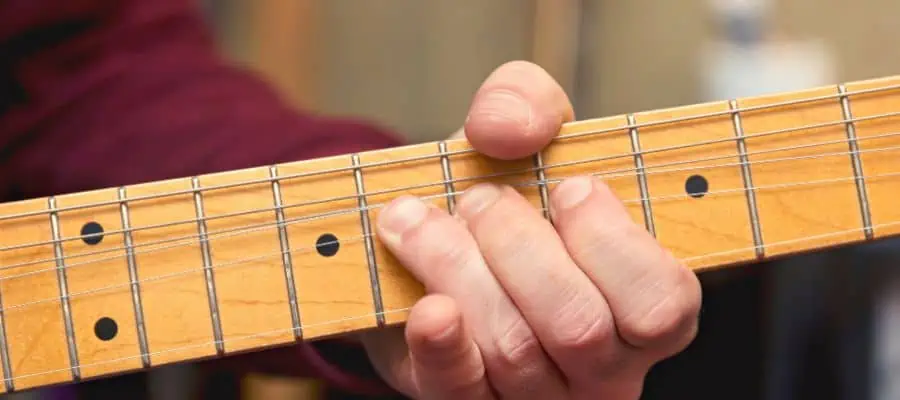If you have been playing guitar for a while and tried some different guitars, you might have noticed that bending feels different in each guitar. With some guitars, it is quite smooth and easy to bend strings, while with others, it is quite challenging. So, what affects the bendability of strings that creates this difference?
One of the most important aspects affecting the bendability of strings is the string gauge, which raises the string tension. Also, the action is the main difference between different guitars. Higher action means more effort to bend.
If you want to know more, stick around! I’ll explain all the reasons why the strings of some guitars are easier to bend and show you which guitar is the easiest to play. Additionally, I’ll show you some tricks to help you bend your guitar strings more easily.
Why It’s Easier To Bend Strings on Some Guitars

When you start playing the guitar, one of the most difficult challenges you face is getting used to bending the strings properly. Guitar strings can be quite sturdy, which may cause your fingers to hurt when bending them. However, some guitars may be relatively easier to play than others.
Several aspects can affect how you bend the strings of your guitar. Some of these factors are the string gauge and the other is action.
String Gauge
The first major aspect that affects the ability of a guitar string to bend is the nature of the strings. Generally speaking, the thicker the string, the less elastic it is and the more difficult it will be for you to bend.
When you buy new strings, you’ll notice that the thickness is measured by the string gauge. The gauge is the string’s diameter; the number on the string pack refers to the thinnest string of the pack.
While you theoretically can choose any string gauge you want for your guitar, you may need to adhere to certain rules depending on your guitar type. Thicker strings will have more string tension, making them harder to bend.
On the other hand, thinner strings are easier to bend, but they are more susceptible to snapping. Also, thinner strings have lower volume, as thicker strings are louder and fatter-sounding. But, this is more important on an acoustic guitar compared to an electric guitar.
Guitar Action
Another important factor that affects the bendability is guitar action. The action refers to the height of the strings from the fretboard. So, the further away the strings are from the fretboard, the more effort you need to play a note and bend the string.
This is quite evident when you compare playing an acoustic guitar and an electric guitar. As acoustic guitars have higher action than electric guitars, bending a string, even a half step, is quite a challenge with acoustic guitars.
Different electric guitars also have different action settings. Neck relief, level frets, and nut slot depth are all factors affecting the action. A guitar needs a straight fretboard, nicely leveled frets, and proper depth in the nut in order to have low action without string buzz.
In theory, any guitar with proper setup can have low action. You can go to a luthier and ask to lower the action, and the luthier can level the frets, adjust the truss rod and the nut slot height, set the bridge and saddle height, and intonate the guitar so that you can have a high bendable guitar.
Guitars like the Ibanez RG Series, ESP LTD Series, along Jackson Pro Series Soloist SL3R, Schecter Sun Valley Super Shredder, and Les Paul Studio are some of the guitars with low actions by default.
Scale Length

Another important factor that affects the bendability is the scale length. When the scale length is larger, the string tension is lower, which means easier bends on the guitar.
As most electric guitars have a scale length between 25.5 inches (650 mm) and 24 inches (610 mm), it may be hard to notice the difference between different electric guitars. However, with baritone guitars, or 3/4 guitars, the bendability will be noticeably different.
Baritone guitars have longer scale lengths, making the bends easier, while 3/4 guitars have shorter scale lengths, which means higher string tension and more difficult bends.
Bridge Type

Another factor is the bridge type, as the bends feel different on guitars with different bridge types, like fixed-type bridges and floating bridges.
When you bend a string on a floating bridge, the whole bridge moves, providing you with more movement freedom, which makes it easier to bend. But, on fixed-type bridges like on headless guitars, bends feel slightly harder as the bridge stays stable. Floating bridges like Floyd Rose bridges are the best for bendability and for players who use the tremolo often to shift the pitch of notes.
Are Electric Guitar Strings Easier To Bend?

Generally speaking, electric guitars have thinner strings than acoustic ones. Although the thickness varies in different instruments, most electric guitars use very light, light, or medium gauge strings, which are quite easy to bend.
As a result, it will be easier for beginners to bend the strings effortlessly with an electric guitar compared to an acoustic one. Although experts are divided on this particular discussion, some argue that the softer strings and the smaller size of electric guitars may help.
An acoustic guitar needs thicker strings because it needs a more powerful sound to produce the desired effect. On the other hand, electric guitars can have thinner strings because their sound is always amplified. In general, when you play the acoustic guitar, you rarely need to bend the strings, as this technique is mostly used with electric guitars.
How To Bend Guitar Strings More Easily

If you’re having difficulties bending your guitar strings, you may consider changing the strings altogether or even giving up. However, there are some tricks that you can use to bend the strings more easily.
First, you can experiment with the string tension and action, as mentioned above. Sometimes they can make a difference in the way you bend your strings. However, I would only recommend this step if you have some knowledge about guitars and understand what you’re changing. If you’re unsure what to do, leave this to a luthier.
Additionally, you can try some techniques that could help you bend the strings correctly. For instance, you can put your thumb over the neck and bend with your ring finger while the index and the middle fingers support the bending finger and give your fingers strength as they bend the strings.
You must also learn how to rotate your wrist to help you bend the strings without moving your fingers. Furthermore, you should practice how to curl your fingers in a way that will secure the string as you bend it. Practice the correct techniques continuously until you can bend the strings effortlessly.
While it may seem challenging initially, bedding guitar strings can become relatively easy with time, even with thicker strings. You can experiment with different guitar settings to see if you can make the job easier for you, but you can also just practice a little bit more to get used to the thicker strings.
Final Thoughts
Bending the guitar strings is one of the main challenges most novice guitar players face. Some strings are noticeably harder to bend because they are thicker. Acoustic guitars generally have thicker strings to produce a more powerful sound.
The tension and action of the string are the factors behind bendability, so you can try to change them to make it easier for you. However, even if you don’t change anything, you may be able to easily bend even the thickest strings if you practice and learn some useful techniques.
If you found this article useful, you may want to save this pin below to your Guitar board.

Recent Posts
Some guitarists insist on buying an expensive amplifier with their electric guitar. They assume that this is a must for every type of guitarist out there. However, in some situations, this isn’t...
Top 50 Free Realistic Guitar VST Plugins With Sound Examples
As technology has rapidly advanced in the recent decade, computers are stealing more and more roles from physical musical instruments and accessories. Nowadays, you do not need expensive amps,...

